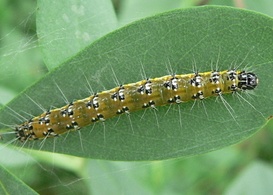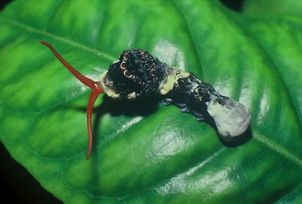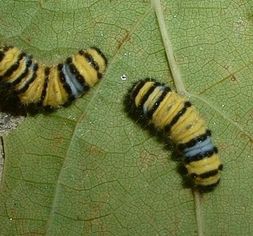Our trees and plants endure a lot during the hot and dry summers, and the Arizona weather isn’t the only thing that affects the material in our landscape. We also have our fair share of insects that cause added stress on our trees and plants. One of the most common insects that can affect your plant material are caterpillars.
There are many varieties of caterpillars that affect different varieties of trees and plants. They eat the foliage off of your plants and cause severe damage. The good news is that they are fairly easy to detect and treat.
The following is a list of the most common caterpillars we see and what to look for.
These caterpillars will spread across the valley regularly and leave easily recognizable damage on your plants.
What to look for: Shrubbery will be left with white, skeletal remains on the affected leaves.
The main plants the skeletonizer enjoys eating are:
Products we carry to treat:

Genista Caterpillar
These caterpillars affect the Texas Mountain Laurel tree and can do severe damage very quickly and can return year after year. It is recommended that if you have a Texas Mountain Laurel to pre-treat for the Genista Caterpillar.
What to look for: Eggs. They can be found in the spring but are very small and not easily seen. Damage will be done around new growth and work its way into the plant. The Genista Caterpillar will eat the leaves and may leave behind webbing or cocoons.
Products we carry at all locations to treat:

Orange Dog Caterpillar
These caterpillars affect citrus trees.
What to look for: These caterpillars will look a lot like bird dropping on your tree. They sometimes put out orange antennas and feed at night. Large trees can generally have a few leaves eaten by the Orange Dog Caterpillar and be just fine however they can come in large numbers or attack younger citrus and it is a good idea to treat for them.
Products we carry at all locations to treat:
When you visit one of your Moon Valley Nursery locations, be sure to ask one of our certified nursery pros for the best way to deal with these caterpillars.
There are many varieties of caterpillars that affect different varieties of trees and plants. They eat the foliage off of your plants and cause severe damage. The good news is that they are fairly easy to detect and treat.
The following is a list of the most common caterpillars we see and what to look for.
 Leaf Skeletonizer
Leaf Skeletonizer
These caterpillars will spread across the valley regularly and leave easily recognizable damage on your plants.
What to look for: Shrubbery will be left with white, skeletal remains on the affected leaves.
The main plants the skeletonizer enjoys eating are:
- Most shrubs from the Tecoma family (Arizona Yellowbells, Orange Jubilee, Bells of Fire, Sparky)
- Bougainvillea
- Grape vines
Products we carry to treat:
- Carbaryl - Comes in a liquid to spray on foliage and will have a residual effect.
- Bt (Bacillus thuringiensis) - Comes in a liquid to spray on foliage or a dust to sprinkle on foliage. B.t. should be applied multiple times as it does not have a long lasting effect.
- Spinosad - Comes in a liquid to spray on foliage and will have a residual effect.

Genista Caterpillar
These caterpillars affect the Texas Mountain Laurel tree and can do severe damage very quickly and can return year after year. It is recommended that if you have a Texas Mountain Laurel to pre-treat for the Genista Caterpillar.
What to look for: Eggs. They can be found in the spring but are very small and not easily seen. Damage will be done around new growth and work its way into the plant. The Genista Caterpillar will eat the leaves and may leave behind webbing or cocoons.
Products we carry at all locations to treat:
- Bt (Bacillus thuringiensis) - Comes in a liquid form and is most effective when the insect is younger. B.t. will need to be applied multiple times as it does not have a long lasting effect.
- Borer, Bagworm, Tent Caterpillar & Leafminer spray (Spinosad) - Comes in a liquid to spray on foliage and will have a residual effect. Most effective for larger caterpillars.
- Tree & Shrub systemic insect drench (Imidacloprid) - Comes in a concentrated liquid to mix and pour around plant base for a long lasting effect.

Orange Dog Caterpillar
These caterpillars affect citrus trees.
What to look for: These caterpillars will look a lot like bird dropping on your tree. They sometimes put out orange antennas and feed at night. Large trees can generally have a few leaves eaten by the Orange Dog Caterpillar and be just fine however they can come in large numbers or attack younger citrus and it is a good idea to treat for them.
Products we carry at all locations to treat:
- Bt (Bacillus thuringiensis) - Comes in a liquid to spray on foliage or a dust to sprinkle on foliage. B.t. should be applied multiple times as it does not have a long lasting effect.
- Borer, Bagworm, Tent Caterpillar & Leafminer spray (Spinosad) - Comes in a liquid to spray on foliage and will have a residual effect.
- Carbaryl - Comes in a liquid to spray on foliage and will have a residual effect.
- Tree & Shrub systemic insect drench (Imidacloprid) - Comes in a concentrated liquid to mix and pour around plant base for a long lasting effect. When using this product on citrus, remove fruit from the tree.
When you visit one of your Moon Valley Nursery locations, be sure to ask one of our certified nursery pros for the best way to deal with these caterpillars.
Submit a Comment